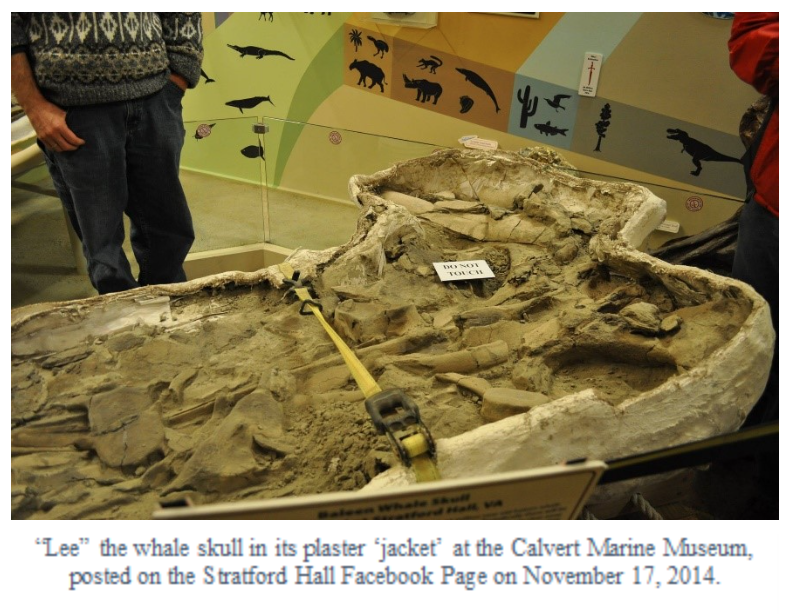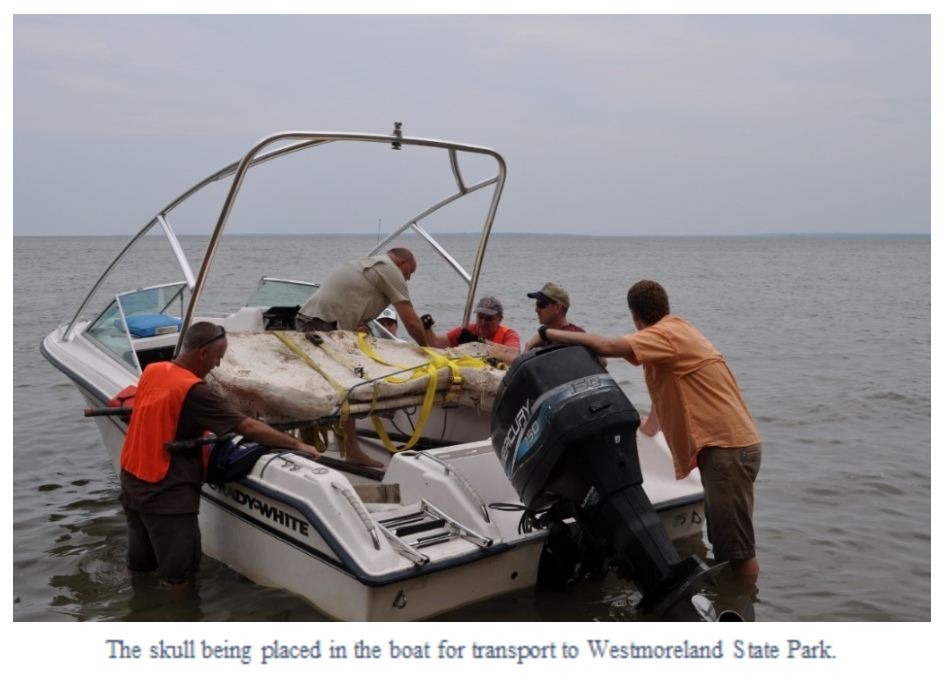Giants in the Cliffs
Giants in the Cliffs
By: Ziv Carmi, Stratford Hall Summer 2020 Intern
Noted geologist John Finch once visited the Stratford Cliffs and asked a fisherman if he knew of any fossils in the cliffs. Finch wrote that “he replied, some giants were buried there, but he did not like to meddle with them…” Years later, one of the ‘giants’ was unearthed, the fossils of a prehistoric baleen whale, Diorocetus hiatus. Many incredible discoveries were made at the Stratford Cliffs, but the excavation of this specimen is undoubtedly one that will go down in history.
Diorocetus hiatus lived during the Miocene Epoch approximately 10 to 15 million years ago.1 The specimen found at the Cliffs falls at the far end of that spectrum and is about 15 million years old, according to John Nance, the paleontology collections manager at the Calvert Marine Museum in Maryland.2 This whale was enormous- its skull alone is about six feet long and weighs about a half a ton! Indeed, the total length of the whale is estimated to be about 35 feet.3 Comparing the specimen with two of its more famous modern relatives, it is slightly smaller than the humpback whale, which has an average length of about 40 to 50 feet, and significantly smaller than blue whale specimens seen in the Northern Hemisphere, which average about 75 to 80 feet in length.4 A similar specimen was found in the same geological formation and helps to explain more about how these whales lived. Bone fractures were found in the other skull, and could either be from predation or a collision with the seafloor or an underwater rock formation5. Furthermore, according to Dr. Robert Boessenecker, an adjunct faculty at the College of Charleston, similar injuries are the most commonly found wounds on dead gray whales6. This indicates a possibility that these ancient whales ate similarly to modern gray whales, which filtered through mud, separated it from benthic (lowest level of a body of water) organisms and sent the mud-water suspension through the baleen, keeping their prey in the mouth while they did.7 Furthermore, researchers found that the ribs of the other specimen were osteosclerotic (incredibly dense). This skeletal property is theorized to have been a sort of ballast to help the whale reach or keep its buoyancy.8

Stratford Hall’s skeleton, nicknamed Lee, was found in the Calvert Formation, near the very bottom of the Cliffs. These cliffs have been valuable resources for understanding life during the Miocene epoch. Indeed, fossils from the Cliffs and the nearby Calvert cliffs in Maryland have appeared in scientific literature since 1770.9 Since then, paleontologists, who have been working for more than a century to catalog and name specimens, have discovered more than 600 fossil species, including shells, sharks, birds, and whales.10 These organisms would have lived in a marine environment much warmer than modern oceans.11 Furthermore, the ocean levels would have been significantly higher than they are now, with a portion of the Atlantic, called the Salisbury Embayment, reaching all the way to where Washington DC currently stands!12 These conditions made an excellent habitat for crocodiles, dolphins, and enormous sharks, all of which have also been found in the Stratford Cliffs.
This specimen was found in July 2013, when Jon Bachman was walking along the beach searching for sharks’ teeth and fossils. According to WYPR, a local radio station, Bachman said that he saw “something that look[ed] like a gray hubcap sticking out about 3 ½ feet from where the cliffs meet the beach”.13 Excavation began shortly afterward, led by Stephen Godfrey, the curator of paleontology at the Calvert Marine Museum.14 According to Godfrey, he had “naively” thought the excavation would be completed quickly, since the back of the skull and lower jaws had become exposed at the base of the cliffs through the process of erosion.15 However, there was no obvious indication that the vertebrae and ribs of the specimen were also buried within the cliffs, as Godfrey and his team would later find.16 By July 20, the skull had been dug from the cliff face, was wrapped in plaster and burlap, and tied to metal poles for transport first to Westmoreland State Park, and from there, to the Calvert Marine Museum.17 The utmost care was taken to ensure that the fossils remained intact during their excavation. After being buried for millions of years, fossils often crumble into pieces when being picked up, so the paleontologists first scraped around the fossil to expose it, then covered the bones with bandages coated in plaster.18 This process, down to the bandages used, is veritably the same process as making a plaster cast for holding broken human bones, and thus effectively keeps the fossils together.19

This find is extraordinary for several reasons, but most importantly, the near completeness of the specimen. When whales die, their bones are usually scattered across the seafloor, making them difficult to dig them all up.20 This dispersion of bones is a result of both the currents and scavengers taking advantage of the body before a sediment buildup that completely entombed the body.21 This whale, however, was surprisingly complete, with several intact vertebrae and ribs. Indeed, according to the Chesapeake Quarterly, while this find is not the most complete of Godfrey’s career, it is among the top few most complete specimens he has discovered.22
Finch said that “Every geologist who wishes to acquire a knowledge of the tertiary formations of the United States, should visit the cliffs at Stratford.” Indeed, with giants like Lee lying in them, the cliffs are a wonderful place to visit for anyone interested in geology or paleontology!
1Ken Benson, “15 million year old whale skull discovered,” Virginia State Parks Blog, July 30, 2013, https://www.dcr.virginia.gov/state-parks/blog/15-million-year-old-whale-skull-discovered-4511
2Martin Weil and Maggie Fazeli Fard, “15 million-year-old whale skull found on banks of Potomac River.” Washington Post, August 5, 2013, https://www.washingtonpost.com/local/15-million-year-old-whale-skull-found-on-banks-of-potomac-river/2013/08/04/415fffa8-fd6b-11e2-bd97-676ec24f1f3f_story.html
3Benson, “15 million year old whale skull discovered”.
4American Cetacean Society
5Boessenecker, Robert, “Benthic feeding in basal mysticetes, part 1: paleopathology of a Miocene ‘cetothere’,” “The Coastal Paleontologist, Atlantic Edition.” http://coastalpaleo.blogspot.com/2010/01/benthic-feeding-in-basal-mysticetes.html
Works Cited
American Cetacean Society. “Blue Whale.” Accessed June 17, 2020. https://www.acsonline.org/blue-whale
American Cetacean Society. “Humpback Whale.” Accessed June 17, 2020. https://www.acsonline.org/humpback-whale
Benson, Ken. “15 million year old whale skull discovered.” Virginia State Parks Blog, July 30, 2013. https://www.dcr.virginia.gov/state-parks/blog/15-million-year-old-whale-skull-discovered-4511
Boessenecker, Robert. “Benthic feeding in basal mysticetes, part 1: paleopathology of a Miocene ‘cetothere’”. “The Coastal Paleontologist, Atlantic Edition.” http://coastalpaleo.blogspot.com/2010/01/benthic-feeding-in-basal-mysticetes.html
The Charleston Museum. “Diorocetus hiatus, Whale skeletal remain.” Accessed June 15, 2020. https://www.charlestonmuseum.org/research/collection/diorocetus-hiatus-whale-skeletal-remain/A48E8D8A-9D55-467F-A393-241312891838
D’Angelo, Pamela. “A Whale of a Find.” WYPR, August 16, 2013. http://news.wypr.org/post/whale-find#stream/0
Godfrey, Stephen J. “The Fossil Whale at Stratford Hall.” Bugeye Times Vol 38, No. 3 (Fall 2013). https://www.calvertmarinemuseum.com/DocumentCenter/View/827/Bugeye-Times-Fall-2013?bidId=
Strain, Daniel. “The Chesapeake’s Excellent Fossils.” Chesapeake Quarterly Vol. 12, No. 4 (December 2013). https://www.chesapeakequarterly.net/V12N4/main2/
Stratford Hall. “Stratford Hall Whale at Calvert Marine Museum.” November 20, 2014. Video, 3:03. https://www.youtube.com/watch?v=WsM-Zyl5SuI
Weil, Martin, and Maggie Fazeli Fard. “15 million-year-old whale skull found on banks of Potomac River.” Washington Post, August 5, 2013. https://www.washingtonpost.com/local/15-million-year-old-whale-skull-found-on-banks-of-potomac-river/2013/08/04/415fffa8-fd6b-11e2-bd97-676ec24f1f3f_story.html

